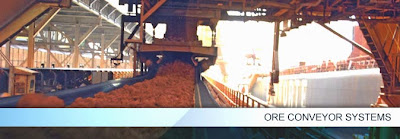These pictures had us scratching our heads
for a while. The analyzer installation is on a roof in South Africa
One by-product of the reaction is hydrogen
and that is the gas they wanted to monitor on this site. Possibly because the
concentration of H2 is an indicator of the pace of the reaction. High or low H2
content may trigger an adjustment in the addition rate of the aluminum
chloride or the aluminum ingots.
The Nova analyzer is easy to identify. It’s
the cabinet with the round port-hole, in the center of each picture. This is a
Model 430N7MC Hydrogen analyzer with explosion-proof cabinet.
The other components attached to it were
more difficult to identify. These were evidently the work of the original
installer. From the site staff explanation, there is apparently a vortex-style
cooler, a ‘silencer’, and a knock-out pot. We assume that the vortex cooler is
intended to cool the gas and cause the moisture to condense and fall out in the
knock-out pot. The ‘silencer’ is perhaps to regulate noise or velocity
associated with the compressed air input (?). The intentions are good, but the
implementation seemed questionable.
A vortex style cooler separates cold and
hot fractions of air by spinning them very quickly. They require an input of
compressed air in the side, and the hot and cold flows usually emerge from
opposite ends of the tube. None of the components in the pictures seem to have
that exact configuration. So we were uncertain about the correct operation of
the installation.
We were also somewhat confused by the
requirement for an explosion-proof analyzer. The components installed ahead of
the analyzer do not seem to reflect this requirement.
Our concerns with the tubing layout and
functionality of the parts were confirmed when it was revealed that the
moisture system was not working properly and was allowing corrosion deposits to
form in the system. The deposits were also apparently contributing to sporadic
Low Flow alarms in the analyzer.
On the right side of the analyzer is a data
collection cabinet or control device of some kind. The analyzer is equipped with a
4-20mA output corresponding to the range of gas analysis. This output is no
doubt connected to the process control panel. Adjustments are automatically
made in response to the hydrogen levels measured.
Last I heard, the plant was looking to
resolve their installation problems and expand their chemical production
capacity. It would make sense to tidy up the loose components and mount them on
a common base plate with an upgraded tubing layout. Sourcing more reliable components
may also be necessary.
Despite the questionable installation, we
were glad to hear that the hydrogen analyzer was performing satisfactorily. If
you have a requirement for H2 measurement in challenging applications, we can
likely offer a solution for you too. Hydrogen page on Nova website.
Episode 1 - old portable flue gas with dual CO channel
Episode 2 - portable ppm H2 analyzer for university metallurgical lab
Episode 2 - portable ppm H2 analyzer for university metallurgical lab
1-800-295-3771
sales at nova-gas dot com
websales at nova-gas dot com
http://www.nova-gas.com/https://twitter.com/NOVAGAS
http://www.linkedin.com/company/nova-analytical-systems-inc-
http://www.tenovagroup.com/
Vortex tube graphic modified from:
http://en.wikipedia.org/wiki/Vortex_tube-


































